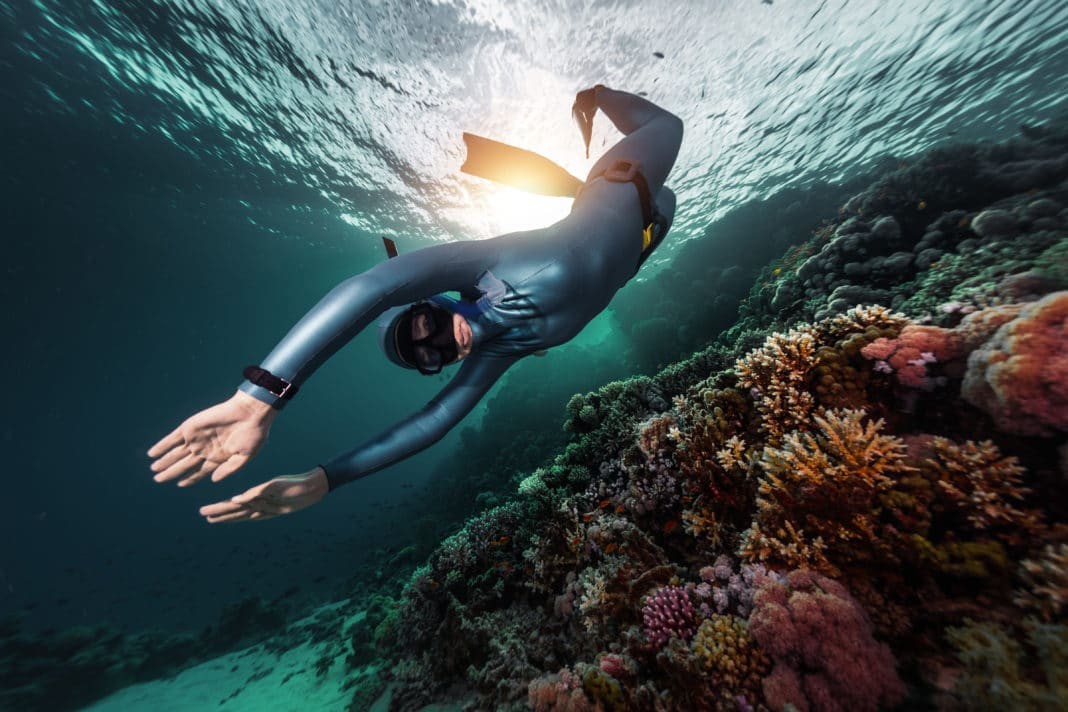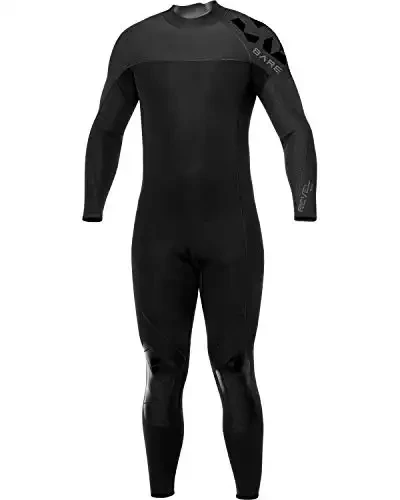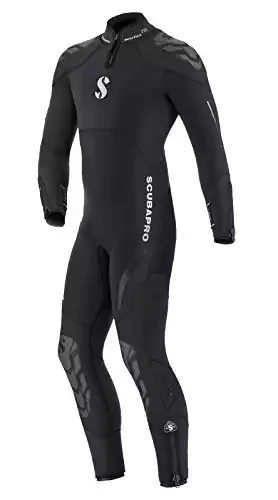Has the time has come in your freediving career where you need your own wetsuit? Terms like “smooth skin” and “open-cell” can be confusing to understand while you are exploring local dive shops or frantically searching online. How do you choose wetsuit thickness, which materials and linings will fit your needs best, or whether you should get a standard size or custom-made suit?
Here is your guide to buying your first freediving wetsuit.
Wetsuit Thickness
The thickness of your wetsuit depends on the temperature of the water you will be freediving in and the amount of time you will be spending in the water.
Since freedivers are not in a state of constant movement the entire time they are in the water, it is important to choose a wetsuit that will keep you warm while you are breathing up and waiting for your turn to dive.
In tropical waters with an almost nonexistent thermocline, you can get away with a rash guard or Lycra suit, mainly for sun and sting protection. 1 or 1.5mm wetsuits are also used for warm waters and are very popular for pool use, where the water temperature is controlled and weights need to be minimal.
But the colder the water is and the more evident the thermocline, you will want to invest in thicker suits, such as 3mm or 5mm thick, even up to 7mm for truly frigid water. Remember that, over time, your wetsuit will compress. A 3mm will not stay 3mm forever, depending on the frequency of use and the depth you are diving to.
Make sure to include that into consideration when choosing wetsuit thickness. Try to choose the thinnest wetsuit that will still keep you warm, but will not require you to add on too much extra weight, which will affect the beginning of your dive and the start of your ascent.
Neoprene is a freediver’s best friend, and there are different combinations of materials and linings that go into making you more hydrodynamic, keeping you warm, and making your wetsuit more durable.
Scuba and Surfing Wetsuits
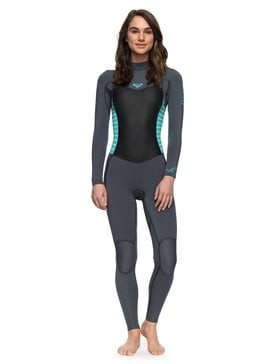
If you already own one of these or are on a budget, you may be able to use a non-freediving wetsuit for your freediving activities.
Advantages:
- Often cheaper than freediving wetsuits
- Protect you from scratches, the sun, and cold to a certain degree
Disadvantages:
- Wetsuits include a zipper, through which water can trickle in
- Use different neoprene
- Scuba wetsuits use denser neoprene to fight against compression at depth, which makes the suit less flexible
- Surfing wetsuit neoprene is not designed to withstand pressure, so it does not last as long
What To Buy
Freediving Wetsuits
Wetsuits designed for freediving usually come in two pieces and include a hood, which stops water from entering into the collar. They also traditionally do not come with a zipper, which provides less opportunity for water to trickle in, and are more flexible, allowing more room to move and breathe.
Double-lining
Double-lining wetsuits are made of neoprene with a nylon covering the inside and outside of the wetsuit. This is the most budget-friendly freediving wetsuit to purchase.
- Advantages:
- Most durable wetsuit
- Easy to put on and take off
- Disadvantages:
- Less warm, since the lining on the inside does not seal as well as open-cell
- Double-lining makes the suit less stretchy than single-lining or no-lining wetsuits
Single-lining
Single-lining wetsuits offer nylon lining on the inside or outside of the suit. Some can be reversible and have different advantages and disadvantages based on how you wear them. They are more durable than no-lining suits but less durable than double-lining suits.
Single-lining outside (also called open cell wetsuits)
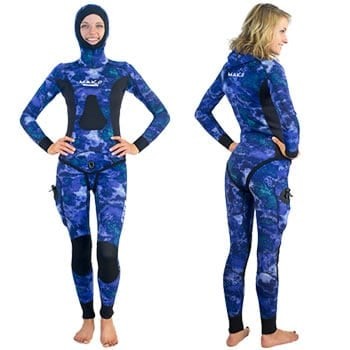
Open-cell refers to naked neoprene. This wetsuit is the most popular for spearfishers and recreational freedivers.
- Advantages:
- Open-cell against your skin minimizes water passage inside the suit, keeping you from getting colder for a longer amount of time
- Lining on the outside makes the suit more durable against scratches
- Disadvantages:
- More difficult to put on, usually requires soapy water, baby powder, or putting it on inside of the water (more environmentally-friendly)
- Needs more care putting on and taking off the wetsuit due to the risk of over-stretching the suit and the open cell being prone to cuts from nails and sharp objects
Single-lining inside (also called smooth skin)
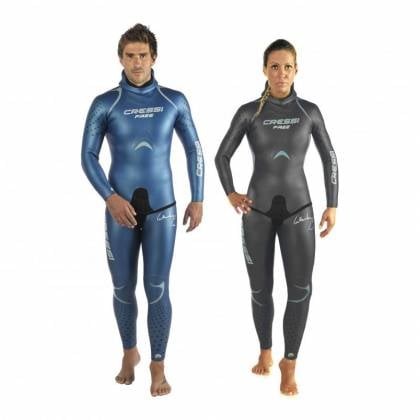
Smoothskin refers to the treatment placed on naked neoprene, where the open cells are smoothed over and closed, which makes the wetsuit more hydrodynamic. This is a popular wetsuit for competitive freedivers.
- Advantages:
- Makes you more hydrodynamic and can increase the speed of your freefall
- Easier to put on and take off due to the nylon lining on the inside
- Can come in a range of colors
- Disadvantages:
- Subject to more cuts and scratches from nails and other sharp objects in the sea
- Exposure to the sun causes the smooth skin to eventually lose color and crack
No-lining
No-lining wetsuits have an open cell inside and smooth skin on the outside. This is one of the most expensive types of wetsuits to buy, usually only used by professional freedivers.
- Advantages:
- Like smooth skin wetsuits, no-lining suits make you more hydrodynamic and can increase the speed of your freefall
- Like open cell wetsuits, naked neoprene against your skin keeps water flow to a minimum and retains heat, keeping you warmer longer
- Disadvantages:
- Very fragile
- More difficult to put on, usually requires soapy water, baby powder, or putting it on inside of the water (more environmentally-friendly)
- Needs more care putting on and taking off the wetsuit due to the risk of over-stretching the suit and the open cell being prone to cuts from nails and sharp objects
Sandwich
Sandwich wetsuits include a layer of nylon sandwiched between an open cell on the inside and smooth skin on the outside. This type of wetsuit is also one of the most expensive types of wetsuits to buy, usually only used by professional freedivers.
- Advantages:
- More durable than no-lining wetsuits
- Like no-lining wetsuits, the open cell on the inside keeps you warmer, longer, and the smooth skin on the outside makes you more hydrodynamic
- Disadvantages:
- Less stretchy than no-lining wetsuits
- Like no-lining wetsuits, sandwich wetsuits are more difficult to put on and require more attention when putting on and taking off the suit due to the fragility of the smooth skin and the open cell
Choosing between Custom or Standard Wetsuits
If you are on a budget, then you can purchase a standard size suit. When possible, try on the suit beforehand, but if this is not possible, take your own measurements and compare them to the manufacturer’s sizing chart.
If you have a little more to spend and cannot find your size in standard wetsuits (i.e. a larger bustline or longer/shorter legs), a custom-made suit is a better option. Apart from customizing colors and designs, you can also specify things like reinforced elbows and knees or different types of fastenings.

